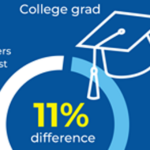The Every Student Succeeds Act has failed to fundamentally alter how the federal government interacts with schools.
The Every Student Succeeds Act (ESSA) was designed to remedy the wrongs of No Child Left Behind (NCLB). After more than a decade in effect, NCLB’s many shortcomings made the law untenable and a target of criticism for both the political left and right. ESSA was supposed to shift policy in substantive and substantial ways from NCLB. So far, however, it has not.
We argue that this is because the U.S. Department of Education is trapped in a bind. Faced with a choice between yielding essential authority and wielding too much (federal) control, it has opted for neither. Instead, it has performed a playact of “fixing the system” — a delay tactic that constitutes a response but not a resolution.
How did the feds become trapped in this bind? From the 1950s through the 1990s, they amassed increasing levels of authority — authority that has been useful in the pursuit of equity. But until the passage of NCLB, in 2001, they possessed little control over the actual operation of schools. To some, that lack of control seemed like a failure of fiduciary responsibility. The feds, they argued, should either relinquish their authority to be commensurate with their low levels of control, or they should increase their control to be commensurate with the authority they supposedly had.
Rather than surrender their authority, federal policy makers — working with allies at the state level — created a more “tightly coupled” system. Via the standards and accountability movement, they created quantitative measurement systems to help them “see” how schools are performing, and they put in place automatic consequences to help them “act” in response to what they saw. Yet such systems proved to be deeply flawed, often failing to accurately measure school quality or intervene in appropriate ways. As a result, these systems triggered resistance and raised questions about their legitimacy.
Hence the bind: If the feds renounce their tools of control — standards, tests, and accountability measures — they will appear derelict in their duties. But if they preserve these flawed systems, they will appear inept. Their solution has been to enact reform without repair. The new boss is the same as the old boss, just with a different name.
The tension between authority and control
Historically, state and federal agencies played a relatively small role in public education. American schools were controlled at the local level, served only local children, and reflected the interests and desires of the local community. In the late 19th century, however, states developed departments of education to address the inevitable discrepancies created by local control; such departments slowly expanded their authority to address inequalities in funding and curriculum. By the dawn of World War II, public education had become the single largest state-level investment, and states made increasingly strong governance claims.
Quantification was not the only approach the feds could have taken to exert greater control over the schools.
Over the subsequent decades, the same logic extended to the federal level — local differences in resources and treatment, it was argued, could be addressed through greater centralization. The 1965 Elementary and Secondary Education Act, for instance, a key element of the Johnson administration’s “War on Poverty,” sought to close funding gaps by infusing federal funds into low-income schools. Toward the end of the century, federal authority expanded even more dramatically, when President George H.W. Bush’s America 2000 project eventually morphed into President Bill Clinton’s Goals 2000 legislation, subsequently paving the way for NCLB. The creation of state standards and aligned tests allowed the feds to mandate performance increases and thereby exert influence not just over processes, but also over outcomes.
During this period, the federal government increased its authority as it established policies addressing funding inequities and systemic discrimination. Yet, even as its authority increased, the federal government’s inability to direct activities inside schools and classrooms left its agencies with little control. Rather than coordination, inspection, and evaluation, authority structures relied on confidence and good faith — in other words, they operated as “loosely coupled” systems.
In the 1980s, conservative policy leaders and their centrist allies lost patience with the logic of confidence. Critics argued that, because government agencies had little control over schools, involvement in education was susceptible to waste and inefficiency. As the tension between the expanding levels of federal authority and their lack of significant control became a point of contention, the feds faced criticism for failing to demonstrate results.
When NCLB was signed into law in 2002, it required that all states test students in reading and math every year from Grades 3-8 and once in high school. States were required to set performance targets and issue sanctions for schools failing to meet them. This shift toward tighter governance was not the product of individual aspirations or motives, nor did it represent an effort to seize direct control over schools. Instead, it was driven by pressure to wield greater levels of (indirect) control over schools and districts. To achieve this control, the U.S. Department of Education — in partnership with state education agencies (SEAs) — turned to curriculum standards and accountability tests. Such tools allowed them to translate school performance into a set of clear metrics, which automatically triggered consequences.
- Related: The essence of ESSA: More control at the district level?
- Related: Is ESSA a retreat from equity?
- Related: Stay the course on standards and accountability
Control via quantification
Quantification was not the only approach the feds could have taken to exert greater control over the schools. Instead, the federal government could have opted for school inspections, for example, or the creation of new local or state governance structures. To maintain political legitimacy, however — particularly in light of the tradition of local control — the U.S. Department of Education sought to depoliticize its work through the use of numerical measurements. The idea was that metrics were politically neutral, objective levers, not subject to the whims of individual actors. Presumably, numbers don’t take sides.
Although ESSA was touted as a return of control to the states, little actually changed on a practical level.
These changes placed both federal and state offices of education in what we call the “iron cage of quantification.” Measurement and accountability systems endowed the feds, as well as SEAs, with newfound levels of control. And quantification lent legitimacy to those control efforts, because it is ostensibly precise and objective. Yet the supposed objectivity and precision of these systems leaves no room for human judgment or admission of error. Without such flexibility, quantitative systems inevitably fail.
But data cannot simply be ignored by central offices, even when they are inconsistent with reality. Central offices must accept the validity of the numbers, not only when the numbers get it right, but also when the numbers get it wrong. We saw this when, for example, award-winning teachers were identified by value-added merics as “underperforming.” Situations like this are impossible to ignore. Thus, measurement and accountability systems respond to one kind of legitimacy threat while creating another.
Fixing the system: From NCLB to ESSA
To address this threat to the legitimacy of their accounting system, centralized offices must respond. But given the iron cage of quantification, there is very little they can do. As a result, they are relegated to refining imperfect measures — a playact that we call “fixing the system.” No such “fix” will be sufficient, because it will inevitably fail to address the root of the problem. Consequently, the new version will resemble the old and will eventually require another “fix.”
The transition from NCLB to ESSA illustrates this playact. NCLB required that states establish Adequate Yearly Progress (AYP) targets, test students in reading and math, publicize data regarding school performance, and sanction underperforming schools. The law also established a highly qualified teacher provision that required all teachers to be trained in the subject area they were teaching.
Over time, NCLB faced many criticisms. From the political left, civil rights groups and teachers unions said NCLB was inequitable to marginalized populations, focused on punishing low-performing schools without providing support for improvement, and incentivized schools to focus instruction on test preparation. From the political right, meanwhile, critics bristled at the growing role of the federal government in education.
ESSA was introduced to address these criticisms. In response to the claims that NCLB narrowed the curriculum to test preparation, ESSA required that states include a nonacademic indicator in their accountability system, which, for many states, meant including attendance. The new law also ostensibly reduced some of the accountability pressure by removing AYP targets. And ESSA responded to concerns from conservatives about the expansion of the federal role into educational policy by restricting the establishment of national standards and hampering the use of waivers by the U.S. Department of Education.
But although ESSA was touted as a return of control to the states, little actually changed on a practical level. States are still held accountable for testing requirements, reporting data, and sanctioning underperformance. States might have additional freedom to, for example, choose their accountability goals, but ESSA does not significantly change how school performance is measured or how the public talks about educational quality. Educators remain concerned about curricular narrowing and teaching to the test. Principals continue to complain that they face overwhelming pressure to raise test scores, even at the expense of other important priorities. Families continue to rely on incomplete information when making school choices. And states still reward and sanction schools based largely on test scores.
Some things are different, certainly. Adequate Yearly Progress is gone, as is the mandate for universal proficiency. States have more leeway in determining how they measure school progress. States are also required to include a “nonacademic indicator” into the accountability system (meant to respond to the critique that educational policy had too narrowly focused on reading and math tests as measures of progress). ESSA also limited the ability of the federal government by restricting any endorsement of national standards and constricting how waivers could be used. But such activity has produced little substantive change. The system was adjusted enough to pacify critics of NCLB without fundamentally altering an accountability system rooted in standards-based testing. Centralized offices of education, however — whether at the federal or state level — remain trapped in the iron cage of quantification. As a result, policy shifts have largely addressed narrow and technical questions like test protocols, rather than overarching questions about broad educational aims.
Rigid flexibility: A third way
Even though ESSA has been a disappointment in its failure to loosen federal control in a significant way, it would be wrong to suggest that the feds should give up all control. To do so would mean also relinquishing their authority to mandate equity in schooling — a goal that can be best pursued with some degree of centralization. Over the past half century, federal authority, whether emanating from civil rights offices or from the Department of Education, has focused public attention on equity and has inspired a great deal of policy. Still, efforts to maximize federal control are concerning because they force a broad system into narrow parameters without necessarily improving teaching and learning.
How, then, could we strike the balance? We must begin with the understanding that some policy issues, like teacher evaluations, require context and insight, and, therefore, should be overseen at the local level. Other policy issues require very little situated knowledge. Safe school facilities and equitable funding, for instance, can be overseen at some distance. However, most policy issues exist somewhere between these poles.
Because individual schools are unique to local communities, some flexibility that allows schools to respond to local conditions, attitudes, and needs is essential. But not every school is entirely distinct, and in the interest of equity, a certain degree of sameness between schools is required. We believe that it might be possible for schools to operate with some degree of both flexibility and sameness, in a model we call “rigid flexibility.” In such a hybridized approach, centralized offices might require certain activities, but allow schools some choice in determining specific goals. As long as each school was meeting the baseline requirements, they could customize the implementation in unique ways.
While such a model may seem idealistic, there are examples of rigid flexibility already at work in American schools. The Coalition of Essential Schools, before its demise, brought together several hundred schools around a set of common principles. The International Baccalaureate program shapes instruction, assessment, and professional development. And, the Knowledge Is Power Program (KIPP) informs all aspects of its member schools, even human resource decisions. But these examples are the exception within a system that is overly prescriptive.
We advocate creating a system where communities can drive flexibility in schooling, and the state provides rigidity by establishing basic requirements around core principles and categorical activity. With regard to the former, schools would remain free, non-discriminatory, and non-sectarian. With regard to the latter, schools would not be required to adopt any particular model favored by the state, even with regard to measurement; instead, they would simply need to demonstrate a coherent approach. Among other things, federal and state offices would require local districts to adopt curricular standards, set clear goals for learning outcomes, and communicate progress. In turn, local communities would be allowed the flexibility to use context-specific knowledge to meet the learning needs of young people, address the concerns of families, draw on the particular strengths of educators, and create an environment that all stakeholders have had a hand in shaping.
The iron cage of quantification is not inevitable or inescapable, and American schools are not doomed to endlessly fail at fixing the system. However, we have to dramatically shift our thinking about reform if we want to create meaningful change. ESSA was written to fix the problems of NCLB, but it did not fundamentally alter the relationship between local schools and centralized offices. Reliant on quantification to produce control commensurate with their authority, and reluctant to relinquish that authority — important as it has been for equity matters — such offices have trapped themselves in an iron cage. There is, however, an alternative.
We hope policy makers, educators, and community members view this as a call to action. Instead of arguing about specific testing procedures or requirements, we urge communities to discuss the larger purposes of education and push for local values to drive how we evaluate schools. While state and federal authorities might give up some control in our proposed model, they might also develop stronger local connections between community members and educators. By ceding some control back to local communities, we could allow for diverse approaches to education that better meet the needs of the American people.
Citation: Saultz, A., Schneider, J., McGovern, K. (2019, Sept. 23). Why ESSA has been reform without repair. Phi Delta Kappan, 101 (2), 18-21.
ABOUT THE AUTHORS

Andrew Saultz
ANDREW SAULTZ is an assistant professor of educational policy at Pacific University, Forest Grove, OR.

Jack Schneider
Jack Schneider is an associate professor of education at the University of Massachusetts, Lowell; co-founder of the Massachusetts Consortium for Innovative Education Assessment; and the director of the Education Commonwealth Project. He is the author of A Wolf at the Schoolhouse Door: The Dismantling of Public Education and the Future of School.

Karalyn McGovern
Karalyn McGovern is a doctoral candidate and research assistant at the University of Massachusetts Lowell.










